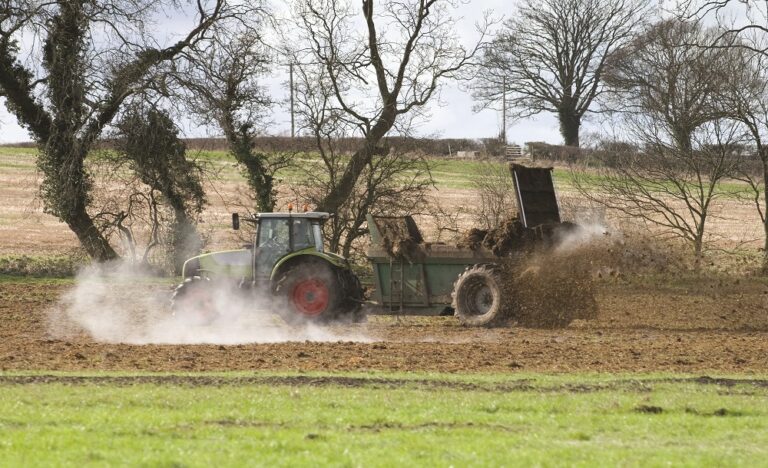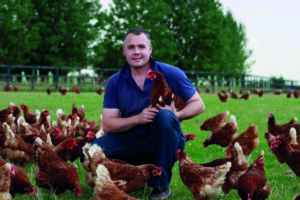25% of all ammonia emissions come from livestock manures spread on land. In its Clean Air Strategy published in January, the government said farmers would be supported to find alternative ways to use muck. So, what are the best ways of making money from poultry manure?
In the government’s Clean Air Strategy, published in January 2019, the topic of muck spreading was given a lot of attention. The report said the government would “require and support farmers to make investments that will reduce emissions.”
Although it’s not yet clear what this will involve, it is clear that legislation and controls on land spreading are likely to become more onerous in future. At a meeting of members of the British Free Range Producers Association (BFREPA) in May, Jason Gittins and Jon Walton of ADAS, discussed the situation with producers and outlined some alternative options.
Gittins and Walton have published a report on behalf of BFREPA called ‘Improving the value and sustainability of laying hen manure’ which examines the various options producers can consider, given the legislative landscape is likely to shift in the coming years.
“Current practices may not be possible in the future,” said Gittins. “Therefore, there is increased interest in alternative uses of poultry manure.”
There are four main alternative ways of dealing with poultry manure other than land spreading.
- Incineration
- Drying and pelleting
- Composting
- Anaerobic digestion
Incineration of poultry manure
Incineration can provide on-farm heat, electricity for your own use or sale, and residual ash which can be used for fertiliser.
Incineration of poultry manure is done through fluidised bed technology. BHSL is the only provider in the UK at the moment, said Gittins, and the process is regulated by APHA. It is fairly expensive to set up, with capital costs between £1.3 million and £2 million.
Other costs include labour, maintenance and start-up fuel. The returns generated from incineration depend on feed-in tariff (FIT) and Renewable Heat Incentive (RHI) rates and the value of the energy generated. Residual ash can be sold as fertiliser around £40/t and the volume of ash is between 8 – 15% of weight of manure.
Drying and pelleting
Manure belts that remove and dry waste from poultry houses typically produce a product containing 80-90% dry matter in 48 hours. The drier the matter, the higher the value. The final weight is around a third of the initial weight.
Gittins said the estimated cost for installing the equipment amounted to around £2.50 per bird on 32,000 unit. Retrofitting of manure belts is possible but the cost is around 20% higher compared to installing them in new buildings. The advantages include low operational costs. The product can be sold for around £41 per tonne for dry manure.
If you then go on to pellet the dry manure, the costs rise. The estimated capital costs for pelleting are equivalent to around £4 per bird. Gittins said it cost between £20-£35 per tonne to produce pellets. There are also big energy costs associated with the pelleting process. It is a competitive market to get into, but the product sells for around £16 per 20kg bag at retail so there are good returns for those who do successfully find a market.
Composting
Poultry manure can also be composted. There are two options, either an open pyramid system or a vessel system such as the module system from Big Dutchman.
The aim of composting is to produce high quality fertiliser for range of outlets. Once composted, poultry manure is lighter and easier to handle with between 60-70% dry matter. It is key to mix the manure with green materials to achieve the right mix of carbon and nitrogen. The process takes 8-12 weeks and run off containment is needed.
There can be low capital costs if producers are able to make use of existing buildings. In vessel systems it typically costs £150 per tonne of material composted per year. However, it is difficult to get good returns on compost and the economic model is usually based on the gate fee charged for incoming raw materials rather than on sale of final compost alone. Producers charge around £20-30 to take easy composting greens, and between £80-90 to take difficult to handle green materials.
Anerobic digestion
Anerobic digestion produces gas that is used to generate electricity. The process gives a good gas yield but there are difficulties to overcome with poultry manure. High nitrogen content, such as poultry manure is generally limited to 20% of feedstock in total. So producers need to find 80% of something else to balance the content. The other problem is the presence of calcium in poultry manure, which clogs up the machine and needs to be removed.
There are several projects aiming to overcome these issues at the moment, said Gittins. “If those come to fruition it opens up the area much more for poultry manure.” There are high costs, estimated at between £1.4m to £2.5m to set up. The returns are dependent on the FIT and RHI and digestate also has value.
Gittins said that although capital costs were generally very high, if there is increased interest, prices may come down in the future. Groups of producers could come together with shared facilities, he suggested. “The economics are dependent on future government policy, but support may be given under any future government’s Clean Air policy.”
Incineration
James Baxter has 128,000 free-range laying hens on his farm near Stranraer in Scotland. He uses an FBC750 Combined Heat and Power (CHP) system from BHSL to incinerate the poultry manure produced, using the energy generated for heating and electricity.
Because of the farm location, Baxter does not supply energy to the national grid so it is all used on farm.
His decision to opt for manure incineration came after a review of a number of different options as alternatives to land-spreading. He considered anaerobic digestion bit identified a number of practical difficulties, concluding that other materials were better suited to the digestion process than the manure from his laying hens.
He also considered other CHP machines, including small scale ‘plug and play’ units, which are often used for power generation in developing countries. A number of other machines and technologies were considered but these were discounted for reasons including lack of track record of burning laying hen manure, the need to pellet the manure prior to incineration, potentially high maintenance costs and concerns over high emission levels.
With a fluidised bed incineration system now in place, Baxter currently burns around 11-12 tonnes of manure each day from his 128,000 hens and sees manure burning as part of an integrated approach with heat being supplied back to the poultry houses to improve the environment and dry the manure in-house on the belts. The electricity generated is used on the farm to reduce the utility costs. Residual ash from the process is used as a fertiliser on farm or sold to other farmers but it is expected that it will soon be sold to fertiliser companies to help them meet their environmental requirements for the use of recycled materials in their products.
Baxter has sought to benefit from government incentive schemes such as RHI and ROCS but he has found the accreditation process to be complex and that expected payments were severely delayed. This could have important negative implications for cash flow for businesses reliant on such payments. Key compliance issues for payments included the need for incoming manure not to have been further processed prior to incineration and there must also be a clear and demonstrable use for the heat and electricity generated.
Overall, he considers that £2 million would be a reasonable budget figure for capital costs for such a development and on that basis accepts that a larger number of birds are needed to justify the investment. However, the development of smaller and therefore cheaper machines in future will happen if demand is, which may create opportunities for others.
Alternatively, installing a unit on a separate industrial or other sire with an on-site demand for heat and electricity could be an alternative model for the future. This could then have manure supplied to it by a number of local producers.
Baxter estimates his annual income from the system is currently around £270,000 per year, based on RHI payments, electricity generated and sales of the ash as fertiliser. Having carefully worked out the costs, he expects the equipment will have been paid for within seven years. This does not take into account any benefits from improved flock performance, which arise from improved environmental conditions, better flock health and higher in-house temperatures in winter, leading to reduced feed use.
Anaerobic digestion
Charles and Jo Mear have a 28,000 bird free-range egg production unit together with egg packing facilities and a mill for producing feed using locally grown wheat. They also manage arable crops on an enterprise of over 80 hectares in Bedfordshire.
Business diversification has been a key focus to ensure profitability and more recently, they have installed a solar PV system and an anaerobic digestion plant for renewable energy and heat production. The renewable heat from the AD plant is used to dry manure over a belt system supplied by Dorset Green Machine, model MB9.
The AD system was installed in 2016 with biogas used for electricity generation through a 165 kilowatt rated output generator. Around 10% of the electricity generated will be used on farm, the rest is fed into the grid. The digester is a horizontal plug flow system which is six metres wide, four metres deep and 42 metres long with a capacity of around 1000m3. The feedstock is 60% maize purpose-grown crops (PGC) and 40% rye PGC grown on their farm or supplied by neighbours. The digester generates 2,500 tonnes per year of solid digestate after separation from the liquid fraction. The original intention was to include laying hen manure within the feedstock mix but the AD system could not operate with the build-up of calcium grit.
The digestion process takes between 60 and 65 days to complete. The digestate is separated through a screw press and the liquid and solid fractions are land spread on the farm for their fertiliser value, replacing bought-in fertilisers. Some is also sold locally as a fertiliser, soil improver or mulch to farmers and allotment groups.
The farm has installed a belt drier to dry the laying hen manure and this operates off the renewable heat from the biogas fuelled CHP generator. Two heat exchangers have been installed to provide heat to the drier.
The birds are housed in flat deck systems with verandas on both sides. The laying cycles are staggered so the farm generates around 300 tonnes of manure every 6.5 months. The drier has a throughput f around 2.4 tonnes per day. The manure entering the system is around 52% dry matter and it is dried to 85% dry matter.
Mear is developing a market for the residual solids produced on the farm and is conducting trials based on dried manure blends with the digestate solid fraction. The farm engages with local allotments and amateur gardeners and employs a consultant to help develop products and markets. To help with the marketing of the dried organic fertiliser products, Mear is experimenting with methods of further processing including a shredder to reduce the particle size of the chicken manure prior to drying, pellet extrusion and packaging. The farm has Leader Grant support for this.
The cost of installing the AD plant, the drying system and all the associated ancillary equipment including digestate liquor lagoons, heat exchangers and air scrubbers was around £1.8 million and it was not without problems. The initial aim was to get to 7.2p per kilowatt hour through the RHI scheme. However, due to the design and build company going into liquidation and rapid changes to government support, the Mears had to accept 3.2p. They have received no payments since the plant first became operational in April 2017 and this has had a huge impact on cashflow.





